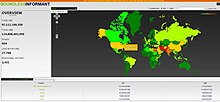
The National Security Agency (NSA) is an intelligence agency of the United States Department of Defense, under the authority of the Director of National Intelligence (DNI). The NSA is responsible for global monitoring, collection, and processing of information and data for global intelligence and counterintelligence purposes, specializing in a discipline known as signals intelligence (SIGINT). The NSA is also tasked with the protection of U.S. communications networks and information systems. The NSA relies on a variety of measures to accomplish its mission, the majority of which are clandestine. The NSA has roughly 32,000 employees.
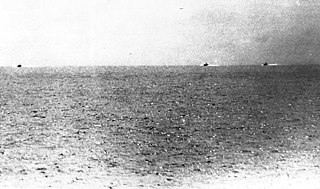
The Gulf of Tonkin incident was an international confrontation that led to the United States engaging more directly in the Vietnam War. It consisted of a confrontation on 2 August 1964, when United States forces were carrying out covert amphibious operations close to North Vietnamese territorial waters, which triggered a response from North Vietnamese forces. The United States government falsely claimed that a second incident occurred on 4 August, between North Vietnamese and United States ships in the waters of the Gulf of Tonkin. Originally, US military claims blamed North Vietnam for the confrontation and the ostensible, but in fact imaginary, incident on 4 August. Later investigation revealed that the second attack never happened. The National Security Agency, an agency of the US Defense Department, had deliberately skewed intelligence to create the impression that an attack had been carried out.

USS Pueblo (AGER-2) is a Banner-class environmental research ship, placed into service during World War II, then converted to a spy ship in 1967 by the United States Navy. She gathered intelligence and oceanographic information, monitoring electronic and radio signals from North Korea. On 23 January 1968, the ship was attacked and captured by a North Korean vessel, in what became known as the "Pueblo incident".

The Central Security Service (CSS) is a combat support agency of the United States Department of Defense which was established in 1972 to integrate the National Security Agency (NSA) and the Service Cryptologic Components (SCC) of the United States Armed Forces in the field of signals intelligence, cryptology, and information assurance at the tactical level. In 2002, the CSS had approximately 25,000 uniformed members. It is part of the United States Intelligence Community.

Technical research ships were used by the United States Navy during the 1960s to gather intelligence by monitoring, recording and analyzing wireless electronic communications of nations in various parts of the world. At the time these ships were active, the mission of the ships was covert and discussion of the true mission was prohibited. The mission of the ships was publicly given as conducting research into atmospheric and communications phenomena. Their designation was AGTR – Auxiliary, General, Technical Research – but it was more or less an open secret that this was a euphemism and they were commonly referred to as "spy ships".

A spy ship or reconnaissance vessel is a dedicated ship intended to gather intelligence, usually by means of sophisticated electronic eavesdropping. In a wider sense, any ship intended to gather information could be considered a spy ship.

DESOTO patrols were patrols conducted by U.S. Navy destroyers equipped with a mobile "van" of signals-intelligence equipment used for intelligence collection in hostile waters. The USS De Haven became the namesake for these patrols. De Haven performed the first patrol off the coast of China in April 1962. The USS Agerholm carried out the first patrol to target North Vietnam in the Gulf of Tonkin in December 1962.
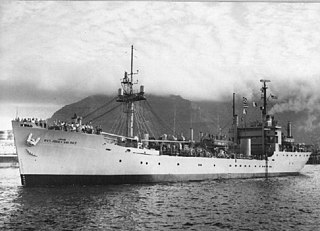
USNS Private Jose F. Valdez (T-AG-169), named after World War II Medal of Honor recipient PFC Jose F. Valdez, was a technical research ship in operation during the 1960s. The "Galloping Ghost of the Ivory Coast" or "Grey Ghost of the African Coast", as she was affectionately called by her crew, was deployed around Africa from 1961 until 1969.

On 15 April 1969, a United States Navy Lockheed EC-121M Warning Star of Fleet Air Reconnaissance Squadron One (VQ-1) on a reconnaissance mission was shot down by a North Korean MiG-21 aircraft over the Sea of Japan. The plane crashed 90 nautical miles (167 km) off the North Korean coast and all 31 Americans on board were killed, which constitutes the largest single loss of U.S. aircrew during the Cold War era.

The 544th Intelligence, Surveillance and Reconnaissance Group is a United States Air Force unit assigned to the Air Combat Command Sixteenth Air Force. It is stationed at Buckley Space Force Base, Colorado. It was reactivated under the 70th Intelligence, Surveillance, and Reconnaissance Wing on 26 September, 2022.
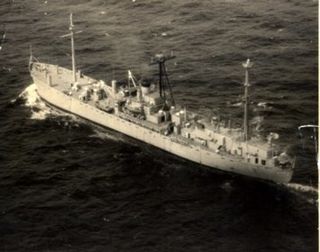
USS Jamestown (AGTR-3/AG-166) was an Oxford-class technical research ship acquired by the U.S. Navy for the task of "conducting research in the reception of electromagnetic propagations" (SIGINT).
PIRAZ is a United States Navy acronym for Positive Identification Radar Advisory Zone. The zone is defined by the air search radar coverage of a ship patrolling a designated PIRAZ station. The concept was similar to radar picket stations established in World War II. The PIRAZ ship requires a Naval Tactical Data System radio-linked computer installation to effectively identify and track all aircraft anticipated to enter the airspace of the zone during combat.
After the end of World War II, all the Western allies began a rapid drawdown of military forces, including those of signals intelligence. At the time, the US still had a COMINT organization split between the Army and Navy. A 1946 plan listed Russia, China, and a [redacted] country as high-priority targets.
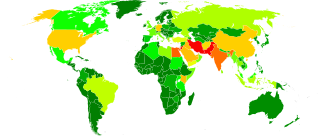
PRISM is a code name for a program under which the United States National Security Agency (NSA) collects internet communications from various U.S. internet companies. The program is also known by the SIGAD US-984XN. PRISM collects stored internet communications based on demands made to internet companies such as Google LLC and Apple under Section 702 of the FISA Amendments Act of 2008 to turn over any data that match court-approved search terms. Among other things, the NSA can use these PRISM requests to target communications that were encrypted when they traveled across the internet backbone, to focus on stored data that telecommunication filtering systems discarded earlier, and to get data that is easier to handle.
Monitoring Station Designators were used by the United States Army Signals Intelligence Service to designate a specific signal intelligence monitoring station in order to allow analysts to understand the source and type of SIGINT they were analyzing. These were used as shorthand rather than writing or typing out the PLA, which consisted of the formal unit name and location of the unit who performed the signals collection.

OAKSTAR is a secret internet surveillance program of the National Security Agency (NSA) of the United States. It was disclosed in 2013 as part of the leaks by former NSA contractor Edward Snowden.

STORMBREW is a secret internet surveillance program of the National Security Agency (NSA) of the United States. It was disclosed in the summer of 2013 as part of the leaks by former NSA contractor Edward Snowden.
Digital Network Intelligence or DNI is a term used in the United States Intelligence Community that refers to "intelligence from intercepted digital data communications transmitted between, or resident on, networked computers."
This is a category of disclosures related to global surveillance.
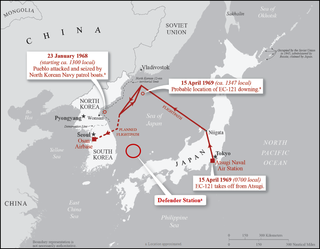
Operation Formation Star was the code name for the emergency re-deployment of U.S. Seventh Fleet warships to the Sea of Japan off the eastern coast of North Korea following that country's seizure of the USS Pueblo (AGER-2) in international waters on 23 January 1968.
